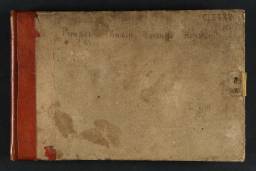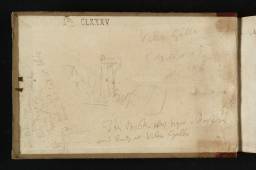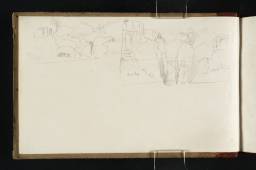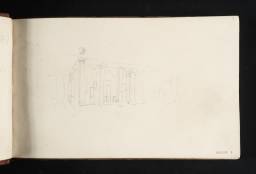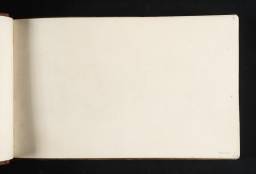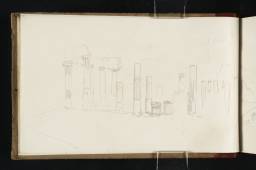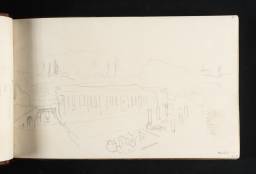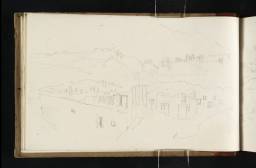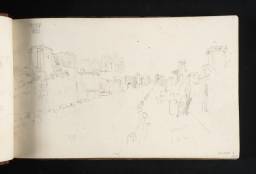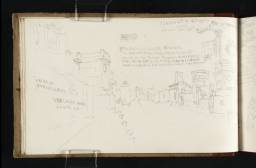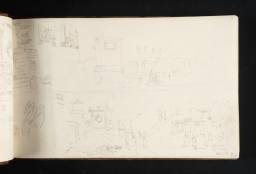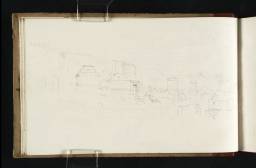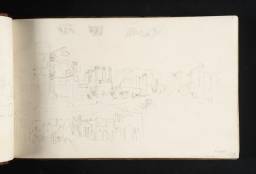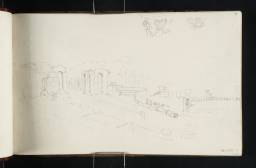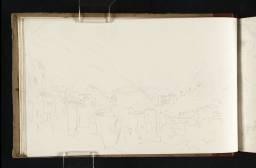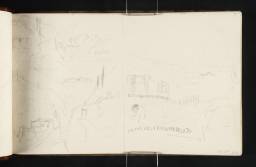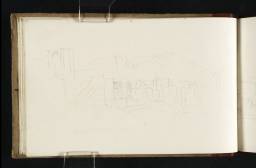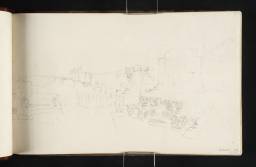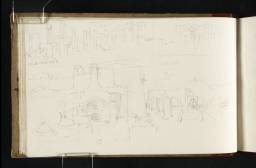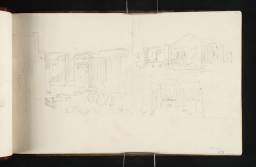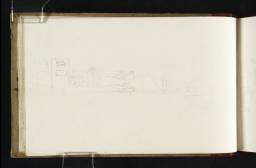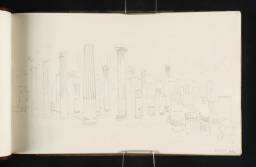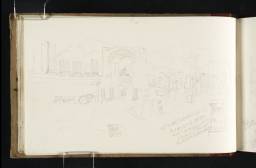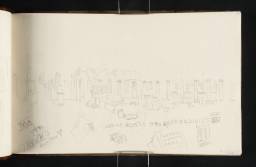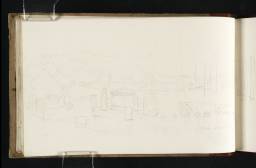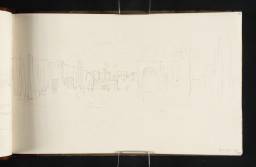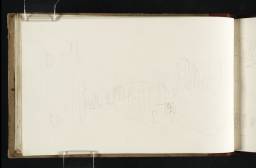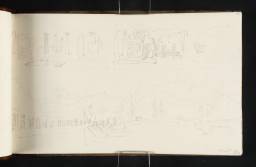Turner Bequest CLXXXV
Sketchbook with paper covered boards bound with a red leather spine, and a brass clasp [missing]
91 leaves of white wove writing paper, approximate page size 113 x 189 mm
Made by Thomas Smith and Henry Allnutt, Ivy Mill, Maidstone, Kent; various pages watermarked ‘[Smith] & Allnutt | ...18’
91 leaves of white wove writing paper, approximate page size 113 x 189 mm
Made by Thomas Smith and Henry Allnutt, Ivy Mill, Maidstone, Kent; various pages watermarked ‘[Smith] & Allnutt | ...18’
Inscribed by the artist in black ink on the front cover ‘Pompeii Amalfi Sorentto Herculani’ top centre (see D40942)
Stamped in black ‘CLXXXV’ top right
Stamped in black ‘CLXXXV’ top right
Back cover stamped in black ‘CLXXXV’ top left. Finberg also records a label by the artist on the back of the book which was destroyed when the covers were broken off.
Accepted by the nation as part of the Turner Bequest 1856
References
Turner used this sketchbook during his first tour of Italy in 1819, one of twenty-three related to that trip. In particular it is one of six sketchbooks which record his expedition to the south of the country.1 As his label on the front cover indicates, the contents comprise studies of the archaeological sites of Pompeii and Herculaneum, and views along the Amalfi and Sorrento coasts, as well as sketches within the city and bay of Naples.
As evident through other sketches from 1819 in the Vatican, at Paestum, and at Hadrian’s villa in Tivoli, Turner was fascinated by the ancient, classical world, traces of which could be found all over Italy. Nearly fifty pages of this sketchbook are devoted to his exploration of Pompeii, the ruins of the city destroyed by the eruption of Vesuvius in AD 79. The site had been rediscovered in 1748 and by 1819 various phases of excavation had uncovered the whole circuit of the city walls, as well as a significant number of buildings in the western half of Pompeii.2 The artist appears to have entered the site from the north-west along the Via dei Sepolcri (Street of Tombs) and the Porta di Ercolano (Herculaneum Gate) and then followed the Via Consolare towards the Forum, only recently uncovered in 1812–13. He also visited the theatre quarter, an area to the south-east formed by an impressive group of structures such as the Large and Small theatres, the Quadriporticus, the Temple of Isis and the Triangular Forum, and finally crossed to the eastern perimeter to see the only public visible structure on this side, the amphitheatre. He made studies wherever he went, some of which are incredibly detailed and others which are swift notations, see folios 2–8 and 9–27 (D15741–D15751 and D15753–D15788). It is not known whether he had a guide around the ruins but often the viewpoints and angles he selected for his drawings consciously or unconsciously mirror those of previous artists and illustrators. By contrast, in nearby Herculaneum, very little had been excavated owing to the greater depth of volcanic material under which the town was buried. The only thing of note to be seen was the theatre which was accessible through a series of underground tunnels dug out during the eighteenth century. Turner’s sketches therefore are restricted to rough, schematic impressions of these dark, restricted spaces, see folios 80–87 verso (D15886–D15899; Turner Bequest CLXXXV 78a–85a).
The rest of the sketchbook is devoted to topographical landscape views, particularly the picturesque scenery of the rocky Amalfi and Sorrento coasts. The order of sketches, however, does not always follow a logical sequence. As Cecilia Powell has suggested, it is likely that the book reflects a clockwise tour in which Turner first visited Pompeii, before journeying to Salerno via the inland road through Nocera and Cava dei Tirreni, and then returning from Salerno by sea via the Sorrentine peninsula and Herculaneum.3 However, the Herculaneum sketches are preceded by views of Naples, suggesting that Turner may have returned to the city before making a separate excursion to the ancient site. These Neapolitan subjects include views related to the ascent of the Posillipo Hill to Virgil’s Tomb, a series of panoramic vistas taken from the Camaldoli Hill and studies of the Porta del Carmine and Porta Capuana. It is also not clear how the book relates to the Naples, Paestum, Rome sketchbook which contains sketches of some of the same places (such as the inland road to Salerno through Cava dei Tirreni and Vietri sul Mare). Anthony Bailey has stated that sketches of the Amalfi coastline from the sea in the Pompeii, Amalfi, Sorrento and Herculaneum sketchbook reveal that Turner returned from Paestum to Naples by boat.4 However, it seems more likely that Turner made two excursions south of Naples, passing Salerno en route to Paestum, and again on a different occasion between Pompeii and Amalfi.
The other sketchbooks containing Neapolitan and southern Italian subjects are Vatican Fragments (Tate; Turner Bequest CLXXX), Albano, Nemi, Rome (Tate; Turner Bequest CLXXXII),Gandolfo to Naples (CLXXXIV), Naples, Paestum, Rome (Tate; Turner Bequest CLXXXVI) and Naples: Rome C. Studies (Tate; Turner Bequest CLXXXVII).
Technical notes
How to cite
Nicola Moorby, ‘Pompeii, Amalfi, Sorrento and Herculaneum sketchbook 1819’, sketchbook, November 2010, in David Blayney Brown (ed.), J.M.W. Turner: Sketchbooks, Drawings and Watercolours, Tate Research Publication, December 2012, https://www

